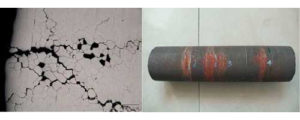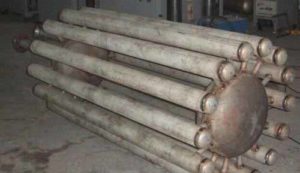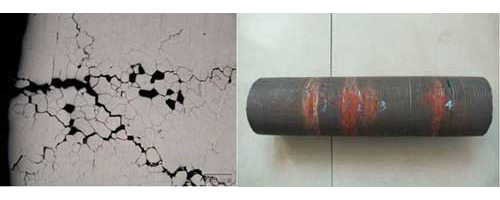Copper alloys for Ammonia corrosion.(HY-industry technical centre)
Study on the corrosion of copper alloys:
 Ammonia-induced stress corrosion cracking (NH3SCC) of copper alloys. Brass and bronze are the copper alloys most prone to ammonia-induced stress corrosion cracking.
Ammonia-induced stress corrosion cracking (NH3SCC) of copper alloys. Brass and bronze are the copper alloys most prone to ammonia-induced stress corrosion cracking.
(1) Sensitivity factors
-
Copper-zinc alloys (brass), including naval brass and aluminum brass(C70600,C71500), are prone to cracking; the zinc content in brass affects sensitivity, especially when the Zn mass fraction exceeds 15%.
-
An aqueous solution of NH3 or ammonium compounds must be present and aerobic.
-
PH is higher than 8.5.
-
It occurs at any temperature.
-
Residual stress promotes cracking and the rolling area is very sensitive.
 2) the appearance or morphology of the damage
2) the appearance or morphology of the damage
-
The surface is cracked with light blue corrosion products.
-
There are single or highly branched cracks on the surface of the heat exchanger tube bundle.
-
Cracks can be transgranular or transgranular, depending on the environment and stress levels.
(3) Protective measures
-
When the Zn mass fraction is reduced below 15%, the corrosion resistance of the copper-zinc alloy is improved. C70600(90-10CuNi) and C71500(70-30CuNi) hardly corrode. SCC in steam environments can sometimes be controlled by preventing air from entering.Check and monitor water samples for pH and NH3 to evaluate the sensitivity of copper alloys. Use eddy current inspection or visual inspection to check for cracks in the tube bundles of the heat exchanger.
(4) Ammonia-induced stress corrosion cracking in refineries
① H2S-NH3-H2O corrosion, the main factors affecting this form of corrosion are:
-
The higher the concentration of NH3 and H2S, the more severe the corrosion;
-
The higher the flow velocity of the fluid in the pipe, the more severe the corrosion;
-
The influence of the presence of certain media, such as the presence of cyanide, will have a strong impact on corrosion, and the presence of oxygen (mainly entering with the injected water) will also accelerate corrosion.
② Ammonia-induced stress corrosion cracking at the top of sulfuric acid alkylation tower
-
In order to control the excessive corrosion of the overhead system of the fractionation section, it is very important to perform alkaline washing and water washing on the reactor products to remove acidic impurities. In overhead systems, neutralizing and film-forming amine corrosion inhibitors have sometimes been used.
-
For reduce the corrosion rate and minimize the amount of corrosion inhibitor, the neutralized amine or NH3 can be used to neutralize the water condensate at the top of the tower to a pH of 6-7. However, in some cases, NH3 can cause stress corrosion cracking of naval brass tubes in tower condensers.
③Catalytic reforming induced stress corrosion cracking
-
In the catalytic reforming unit, three types of stress corrosion cracking can occur, one of which is ammonia-induced stress corrosion cracking.NH3 exists in the effluent of the pretreatment reactor and the reforming reactor and is dissolved in water to form ammonia , Make the copper-based alloy stress corrosion cracking quickly.
④Ammonia-induced stress corrosion cracking of delayed coking unit
-
The equipment in the delayed coking unit is susceptible to many low temperature corrosion mechanisms, including ammonia-induced stress cracking of copper-based alloys. These corrosion mechanisms work when the coking tower performs water quenching, water vapor coking, and venting operations.
-
However, since all coking towers usually have vent pipes and blowdown tanks, they are almost continuously exposed to wet vent steam and liquid.
-
Quench water and vented vapors and liquids usually contain large amounts of H2S, NH3, NH4Cl, NH4HS and cyanide. These corrosive agents are released from the thermal cracking reaction of the coking unit feed. In the coking plant, due to the presence of NH3, ammonia-induced stress corrosion cracking will occur in copper alloy pipes where the pH of the solution is relatively high.
⑤Sulfur recovery equipment corrosion problem ammonia-induced stress corrosion cracking
-
The gas feed is usually rich in H2S and saturated water vapor, and may also contain inclusions of hydrocarbons and amines. These conditions of use can cause H to penetrate into the steel. Therefore, the danger of hydrogen-induced cracking (including hydrogen bulging) and sulfide stress cracking (SSC) in the gas feed must be considered.
-
In addition, there may be NH3 in the gas feed, which will cause NH3 stress corrosion cracking. If there is cyanide, the corrosion rate will be accelerated.


